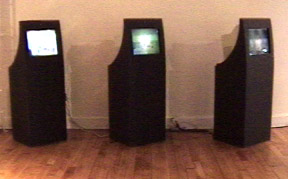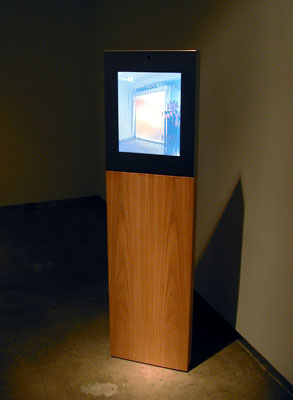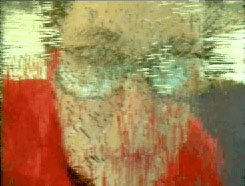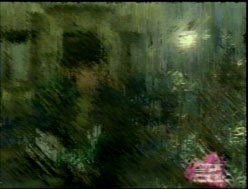
Mirrors # 2, 3, 4 as displayed at ITP NYU March 2001
Mirrors # 2, 3, 4
Mirrors # 2,3,4 are three Kiosk-type installations that involve the viewer in a mirror
type interaction. The kiosks have a video camera in them, and whoever is in front
of them is incorporated into the piece. All three pieces deal with the way digital
images and motion are reproduced and perceived All three pieces use custom software
written as Xtras for Director and the result is shown on 21 inch monitors in the
kiosk.

Mirrors # 2, 3, 4 as displayed at ITP NYU March 2001

Mirrors # 2, 3, 4 kiosk

Mirror #2 Click to view QuickTime movie
Mirror #2 questions the way digital images are represented. Normally we think of digital images as comprised of numerous pixels. These pixels stay in their dedicated positions (X by Y) and change their color to reflect new images as these appear. In Mirror #2 the pixels are few (1000) and they are free to move about the image as they like according to their own logic. As a byproduct of their movement the pixels also gradually create an image. The pixels do change their color periodically to that of the people in front of the installation hence creating their reflection. The installation revolves between 5 different effects, each lasting one minute. The first effect is random, the pixels randomly move about, this creates an effect rather like an oil painting. The second effect is rain, the pixels gradually move downwards and to the right, creating an effect similar to water. The third effect is geometric lines, the pixels follow a formula that sends them on angled lines, this create an effect of a cubist nature. The fourth effect is color dependent, according to their color the pixels move in a given angle, this creates an effect similar to a charcoal drawing. The fifth effect is circles, the pixels move in large circles. The last effect is zoom, the pixels come from the center of the screen towards the edges giving a zoom or stars illusion.

Mirror #3 Click to view QuickTime movie
Mirror # 3 deals with the reuse of visual material. In this case the installation is connected to a live feed of television, and to a camera that captures the image of the viewer. The computer then chops the television image into small squares and rearranges theses squares so that the image of the viewer is created. Every square is used once so in affect all the TV image is present in the viewer's image. The installation cycles between showing the TV image and the resulting mosaic image. In between it animates to demonstrate where the squares are coming from.

Mirror #4 Click to view QuickTime movie
Mirror # 4 is not a mirror in the sense that the other ones are. It does not involve the viewer in any way. The installation is connected to a live feed of television (The same as Mirror # 3) It applies the same effect as Mirror # 2 to the image (the one where the pixels change their angle according to their color) it does this very fast , around 200 times per second. The result is a very smooth and rich flow of pixels on the screen. This installation takes television and strips it from its content, by the time the effect is applied one cannot tell what the program is about. It only uses the color and motion of the television which is probably its best feature.